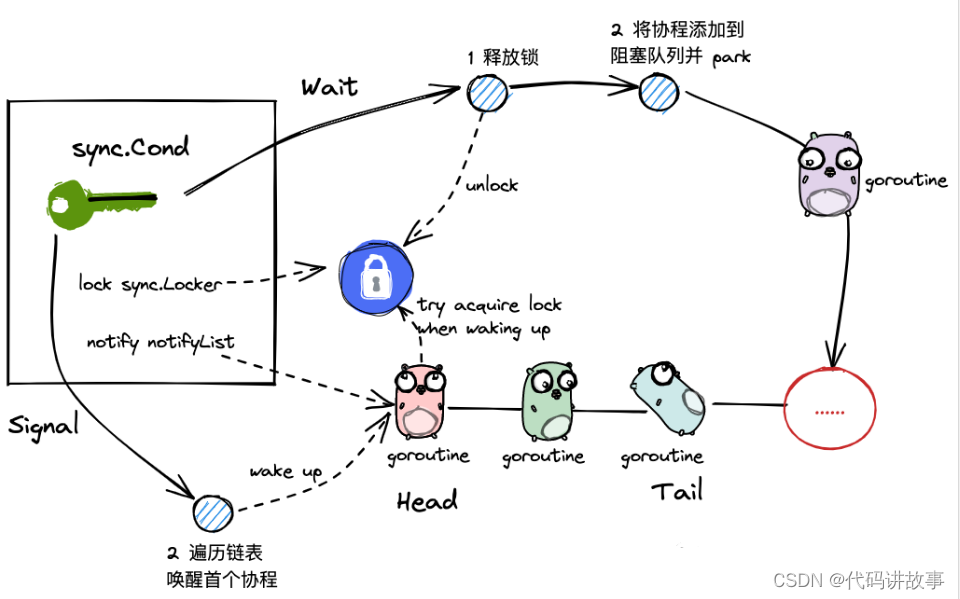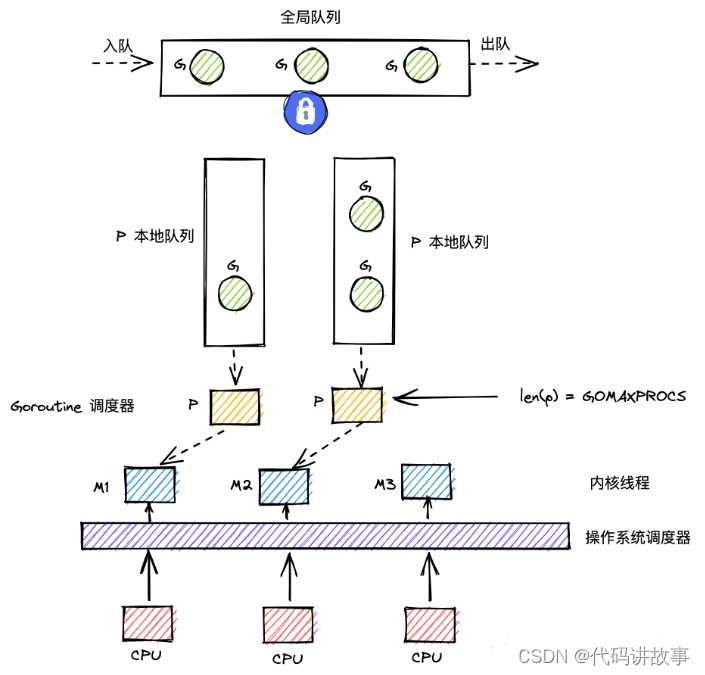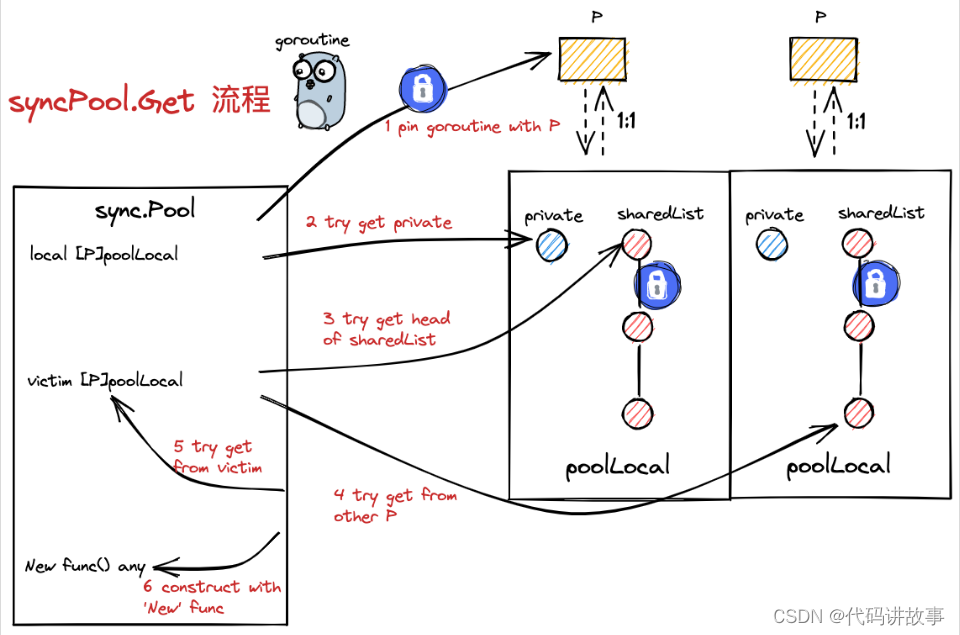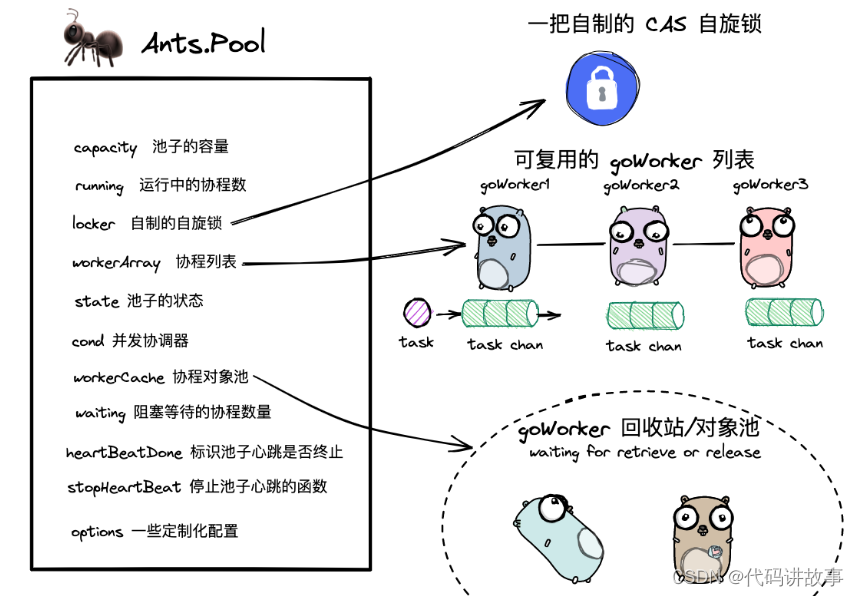Golang 协程池 Ants 实现原理,附详细的图文说明和代码。
1 前置知识点
1.1 sync.Locker
sync.Locker 是 go 标准库 sync 下定义的锁接口:
// A Locker represents an object that can be locked and unlocked.
type Locker interface {
Lock()
Unlock()
}
任何实现了 Lock 和 Unlock 两个方法的类,都可以作为一种锁的实现,最常见的为 go 标准库实现的 sync.Mutex.
在 ants 中,作者不希望使用 Mutex 这种重锁,而是自定义实现了一种轻量级的自旋锁:

该锁实现原理:
• 通过一个整型状态值标识锁的状态:0-未加锁;1-加锁;
• 加锁成功时,即把 0 改为 1;解锁时则把 1 改为 0;改写过程均通过 atomic 包保证并发安全;
• 加锁通过 for 循环 + cas 操作实现自旋,无需操作系统介入执行 park 操作;
• 通过变量 backoff 反映抢锁激烈度,每次抢锁失败,执行 backoff 次让 cpu 时间片动作;backoff 随失败次数逐渐升级,封顶 16.
type spinLock uint32
const maxBackoff = 16
func (sl *spinLock) Lock() {
backoff := 1
for !atomic.CompareAndSwapUint32((*uint32)(sl), 0, 1) {
for i := 0; i < backoff; i++ {
runtime.Gosched()
}
if backoff < maxBackoff {
backoff <<= 1
}
}
}
func (sl *spinLock) Unlock() {
atomic.StoreUint32((*uint32)(sl), 0)
1.2 sync.Cond
sync.Cond 是 golang 标准库提供的并发协调器,用于实现在指定条件下阻塞和唤醒协程的操

1.2.1 数据结构与构造器方法
type Cond struct {
noCopy noCopy
// L is held while observing or changing the condition
L Locker
notify notifyList
checker copyChecker
}
// NewCond returns a new Cond with Locker l.
func NewCond(l Locker) *Cond {
return &Cond{
L:
• 成员变量 noCopy + checker 是一套组合拳,保证 Cond 在第一次使用后不允许被复制;
• 核心变量 L,一把锁,用于实现阻塞操作;
• 核心变量 notify,阻塞链表,分别存储了调用 Cond.Wait() 方法的次数、goroutine 被唤醒的次数、一把系统运行时的互斥锁以及链表的头尾节点.
type notifyList struct {
wait uint32
notify uint32
lock uintptr // key field of the mutex
head unsafe.Pointer
tail unsafe.Pointer
}
1.2.2 Cond.Wait
func (c *Cond) Wait() {
c.checker.check()
t := runtime_notifyListAdd(&c.notify)
c.L.Unlock()
runtime_notifyListWait(&c.notify, t)
c.L.Lock()
}
• 检查 Cond 是否在使用过后被拷贝,是则 panic;
• 该 Cond 阻塞链表 wait 统计数加 1;
• 当前协程释放锁,因为接下来即将被操作系统 park;
• 将当前协程包装成节点,添加到 Cond 的阻塞队列当中,并调用 park 操作将当前协程挂起;
• 协程被唤醒后,重新尝试获取锁.
1.2.3 Cond.Signal
func (c *Cond) Signal() {
c.checker.check()
runtime_notifyListNotifyOne(&c.notify)
}
• 检查 Cond 是否在首次使用后被拷贝,是则 panic;
• 该 Cond 阻塞链表 notify 统计数加 1;
• 从头开始遍历阻塞链表,唤醒一个等待时间最长的 goroutine.
1.2.4 Cond.BroadCast
func (c *Cond) Broadcast() {
c.checker.check()
runtime_notifyListNotifyAll(&c.notify)
}
• 检查 Cond 是否在首次使用后被拷贝,是则 panic;
• 取 wait 值赋值给 notify;
• 唤醒阻塞链表所有节点.
1.3 sync.Pool
sync.Pool 是 golang 标准库下并发安全的对象池,适合用于有大量对象资源会存在被反复构造和回收的场景,可缓存资源进行复用,以提高性能并减轻 GC 压力.
1.3.1 gmp 原理简述
g:goroutine;
m:类比内核线程;
p:调取器,通常 p 的数量等于 cpu 核数.
• p 为中枢,m 通过与 p 的结合,调度 g;
• p 有本地 g 队列和全局 g 队列,前者取 g 不加锁,后者加锁;
• 抢占式调度,g 因为阻塞或者时间片耗尽,可能回到等待队列,最终前后可能被不同的 g 和 m 执行.

1.3.2 数据结构
type Pool struct {
noCopy noCopy
local unsafe.Pointer // local fixed-size per-P pool, actual type is [P]poolLocal
localSize uintptr // size of the local array
victim unsafe.Pointer // local from previous cycle
victimSize uintptr // size of victims array
// New optionally specifies a function to generate
// a value when Get would otherwise return nil.
// It may not be changed concurrently with calls to Get.
New func()
• noCopy 防拷贝标志;
• local 类型为 [P]poolLocal 的数组,数组容量 P 为 goroutine 处理器 P 的个数;
• victim 为经过一轮 gc 回收,暂存的上一轮 local;
• New 为用户指定的工厂函数,当 Pool 内存量元素不足时,会调用该函数构造新的元素.
type poolLocal struct {
poolLocalInternal
}
// Local per-P Pool appendix.
type poolLocalInternal struct {
private any // Can be used only by the respective P.
shared poolChain // Local P can pushHead/popHead; any P can popTail.
}
• poolLocal 为 Pool 中对应于某个 P 的缓存数据;
• poolLocalInternal.private:对应于某个 P 的私有元素,操作时无需加锁;
• poolLocalInternal.shared: 某个 P 下的共享元素链表,由于各 P 都有可能访问,因此需要加锁.
1.3.3 核心方法
I Pool.pin
func (p *Pool) pin() (*poolLocal, int) {
pid := runtime_procPin()
s := runtime_LoadAcquintptr(&p.localSize) // load-acquire
l := p.local // load-consume
if uintptr(pid) < s {
return indexLocal(l, pid), pid
}
return p.pinSlow()
}
• pin 方法内部通过 native 方法 runtime_procPin 取出当前 P 的 index,并且将当前 goroutine 与 P 进行绑定,短暂处于不可抢占状态;
• 如果是首次调用 pin 方法,则会走进 pinSlow 方法;
• 在pinSlow 方法中,会完成 Pool.local 的初始化,并且将当前 Pool 添加到全局的 allPool 数组中,用于 gc 回收;
II Pool.Get

func (p *Pool) Get() any {
l, pid := p.pin()
x := l.private
l.private = nil
if x == nil {
x, _ = l.shared.popHead()
if x == nil {
x = p.getSlow(pid)
}
}
runtime_procUnpin()
if x == nil && p.New != nil {
x = p.New()
}
return x
}
• 调用 Pool.pin 方法,绑定当前 goroutine 与 P,并且取得该 P 对应的缓存数据;
• 尝试获取 P 缓存数据的私有元素 private;
• 倘若前一步失败,则尝试取 P 缓存数据中共享元素链表的头元素;
• 倘若前一步失败,则走入 Pool.getSlow 方法,尝试取其他 P 缓存数据中共享元素链表的尾元素;
• 同样在 Pool.getSlow 方法中,倘若前一步失败,则尝试从上轮 gc 前缓存中取元素(victim);
• 调用 native 方法解绑 当前 goroutine 与 P
• 倘若(2)-(5)步均取值失败,调用用户的工厂方法,进行元素构造并返回.
III Put
// Put adds x to the pool.
func (p *Pool) Put(x any) {
if x == nil {
return
}
l, _ := p.pin()
if l.private == nil {
l.private = x
} else {
l.shared.pushHead(x)
}
runtime_procUnpin()
}
• 判断存入元素 x 非空;
• 调用 Pool.pin 绑定当前 goroutine 与 P,并获取 P 的缓存数据;
• 倘若 P 缓存数据中的私有元素为空,则将 x 置为其私有元素;
• 倘若未走入(3)分支,则将 x 添加到 P 缓存数据共享链表的末尾;
• 解绑当前 goroutine 与 P.
1.3.4 回收机制
存入 pool 的对象会不定期被 go 运行时回收,因此 pool 没有容量概念,即便大量存入元素,也不会发生内存泄露.
具体回收时机是在 gc 时执行的:
func init() {
runtime_registerPoolCleanup(poolCleanup)
}
func poolCleanup() {
for _, p := range oldPools {
p.victim = nil
p.victimSize = 0
}
for _, p := range allPools {
p.victim = p.local
p.victimSize = p.localSize
p.local = nil
p.localSize = 0
}
oldPools, allPools = allPools, nil
}
• 每个 Pool 首次执行 Get 方法时,会在内部首次调用 pinSlow 方法内将该 pool 添加到迁居的 allPools 数组中;
• 每次 gc 时,会将上一轮的 oldPools 清空,并将本轮 allPools 的元素赋给 oldPools,allPools 置空;
• 新置入 oldPools 的元素统一将 local 转移到 victim,并且将 local 置为空.
综上可以得见,最多两轮 gc,pool 内的对象资源将会全被回收.
2 Ants
2.1 基本信息
ant 源码:https://github.com/panjf2000/ants
2.2 为什么用协程池?
• 提升性能:主要面向一类场景:大批量轻量级并发任务,任务执行成本与协程创建/销毁成本量级接近;
• 有一个并发资源控制的概念:研发能够明确系统全局并发度以及各个模块的并发度上限;
• 协程生命周期控制:实时查看当前全局并发的协程数量;有一个统一的紧急入口释放全局协程.
2.3 核心数据结构

2.3.1 goWorker
type goWorker struct {
pool *Pool
task chan func()
recycleTime time.Time
}
goWorker 可以简单理解为一个长时间运行而不回收的协程,用于反复处理用户提交的异步任务,其核心字段包含:
• pool:goWorker 所属的协程池;
• task:goWorker 用于接收异步任务包的管道;
• recycleTime:goWorker 回收到协程池的时间.
2.3.2 Pool
type Pool struct {
capacity int32
running int32
lock sync.Locker
workers workerArray
state int32
cond *sync.Cond
workerCache sync.Pool
waiting int32
heartbeatDone int32
stopHeartbeat context.CancelFunc
options *Options
}
Pool 就是所谓的协程池,其包含的成员字段如下:
• capacity:池子的容量
• running:出于运行中的协程数量
• lock:自制的自旋锁,保证取 goWorker 时并发安全
• workers:goWorker 列表,即“真正意义上的协程池”
• state:池子状态标识,0-打开;1-关闭
• cond:并发协调器,用于阻塞模式下,挂起和唤醒等待资源的协程
• workerCache:存放 goWorker 的对象池,用于缓存释放的 goworker 资源用于复用. 对象池需要区别于协程池,协程池中的 goWorker 仍存活,进入对象池的 goWorker 严格意义上已经销毁;
• waiting:标识出于等待状态的协程数量;
• heartbeatDone:标识回收协程是否关闭;
• stopHeartbeat:用于关闭回收协程的控制器函数;
• options:一些定制化的配置.
2.3.3 options
type Options struct {
DisablePurge bool
ExpiryDuration time.Duration
MaxBlockingTasks int
Nonblocking bool
PanicHandler func(interface{
})
}
协程池定制化参数集合,包含配置项如下:
• DisablePurge:是否允许回收空闲 goWorker;
• ExpiryDuration: 空闲 goWorker 回收时间间隔;仅当 DisablePurge 为 false 时有效;
• Nonblocking:是否设置为非阻塞模式,若是,goWorker 不足时不等待,直接返回 err;
• MaxBlockingTasks:阻塞模式下,最多阻塞等待的协程数量;仅当 Nonblocking 为 false 时有效;
• PanicHandler:提交任务发生 panic 时的处理逻辑;
2.3.4 workerArray
type workerArray interface {
len() int
isEmpty() bool
insert(worker *goWorker) error
detach() *goWorker
retrieveExpiry(duration time.Duration) []*goWorker
reset()
}
• workerArray 是一个 interface,其实现包含 stack 栈版本和 queue 队列包含;
• 该 interface 主要定义了作为数据集合的几个通用 api,以及用于回收过期 goWorker 的 api.
此处仅展示基于 stack 数据结构实现的 goWorker 列表:
type workerStack struct {
items []*goWorker
expiry []*goWorker
}
func newWorkerStack(size int) *workerStack {
return &workerStack{
items: make([]*goWorker, 0, size),
}
• items:存放的 goWorker 列表;
• expire:用于临时存放已过期的 goWorker 集合;
下面几个方法,是 workerStack 作为一个栈的数据结构所提供的一些能力,核心方法为 insert 和 detach 分别为对栈插入或者取出一个 goWorker.
func (wq *workerStack) len() int {
return len(wq.items)
}
func (wq *workerStack) isEmpty() bool {
return len(wq.items) == 0
}
func (wq *workerStack) insert(worker *goWorker) error {
wq.items = append(wq.items, worker)
return nil
}
func (wq *workerStack) detach() *goWorker {
l := wq.len()
if l == 0 {
return nil
}
w := wq.items[l-1]
wq.items[l-1] = nil // avoid memory leaks
wq.items = wq.items[:l-1]
return w
}
下述的 retrieveExpire 方法是从 workerStack 中获取到已经过期的 goWorker 集合;其中 goWorker 的回收时间与入栈先后顺序相关,因此可以借助 binarySearch 方法基于二分法快速获取到目标集合.
func (wq *workerStack) retrieveExpiry(duration time.Duration) []*goWorker {
n := wq.len()
if n == 0 {
return nil
}
expiryTime := time.Now().Add(-duration)
index := wq.binarySearch(0, n-1, expiryTime)
wq.expiry = wq.expiry[:0]
if index != -1 {
wq.expiry = append(wq.expiry, wq.items[:index+1]...)
m := copy(wq.items, wq.items[index+1:])
for i := m; i < n; i++ {
wq.items[i] = nil
}
wq.items = wq.items[:m]
}
return wq.expiry
}
func (wq *workerStack) binarySearch(l, r int, expiryTime time.Time) int {
var mid int
for l <= r {
mid = (l + r) / 2
if expiryTime.Before(wq.items[mid].recycleTime) {
r = mid - 1
} else {
l = mid + 1
}
}
return
}
2.4 核心 api
2.4.1 pool 构造器方法
func NewPool(size int, options ...Option) (*Pool, error) {
opts := loadOptions(options...)
// 读取用户配置,做一些前置校验,默认值赋值等前处理动作...
p := &Pool{
capacity: int32(size),
lock: internal.NewSpinLock(),
options: opts,
}
p.workerCache.New = func() interface{
} {
return &goWorker{
pool: p,
task: make(chan func(), workerChanCap),
}
}
p.workers = newWorkerArray(stackType, 0)
p.cond = sync.NewCond(p.lock)
var ctx context.Context
ctx, p.stopHeartbeat = context.WithCancel(context.Background())
go p.purgePeriodically(ctx)
return p, nil
}
• 读取用户传的配置参数,做一些校验和默认赋值的前处理动作;
• 构造好 Pool 数据结构;
• 构造好 goWorker 对象池 workerCache,声明好工厂函数;
• 构造好 Pool 内部的 goWorker 列表;
• 构造好 Pool 的并发协调器 cond;
• 异步启动 goWorker 过期销毁协程.
2.4.2 pool 提交任务
func (p *Pool) Submit(task func()) error {
var w *goWorker
if w = p.retrieveWorker(); w == nil {
return ErrPoolOverload
}
w.task <- task
return nil
}
• 从 Pool 中取出一个可用的 goWorker;
• 将用户提交的任务包添加到 goWorker 的 channel 中.
func (p *Pool) retrieveWorker() (w *goWorker) {
spawnWorker := func() {
w = p.workerCache.Get().(*goWorker)
w.run()
}
p.lock.Lock()
w = p.workers.detach()
if w != nil {
p.lock.Unlock()
} else if capacity := p.Cap(); capacity == -1 || capacity > p.Running() {
p.lock.Unlock()
spawnWorker()
} else {
if p.options.Nonblocking {
p.lock.Unlock()
return
}
retry:
if p.options.MaxBlockingTasks != 0 && p.Waiting() >= p.options.MaxBlockingTasks {
p.lock.Unlock()
return
}
p.addWaiting(1)
p.cond.Wait() // block and wait for an available worker
p.addWaiting(-1)
var nw int
if nw = p.Running(); nw == 0 {
// awakened by the scavenger
p.lock.Unlock()
spawnWorker()
return
}
if w = p.workers.detach(); w == nil {
if nw < p.Cap() {
p.lock.Unlock()
spawnWorker()
return
}
goto retry
}
p.lock.Unlock()
}
return
}
• 声明了一个构造 goWorker 的函数 spawnWorker 用于兜底,内部实际上是从对象池 workerCache 中获取 goWorker;
• 接下来的核心逻辑就是加锁,然后尝试从池子中取出 goWorker 执行任务;
• 倘若池子容量超限,且池子为阻塞模式,则基于并发协调器 cond 挂起协程阻塞等待;
• 倘若池子容量超限,且池子为非阻塞模式,直接抛回错误;
• 倘若池子容量未超限,且未取到 goWorker,调用 spawnWorker 构造新的 goWorker 用于执行任务.
2.4.3 goWorker 运行
func (w *goWorker) run() {
w.pool.addRunning(1)
go func() {
defer func() {
w.pool.addRunning(-1)
w.pool.workerCache.Put(w)
if p := recover(); p != nil {
// panic 后处理
}
w.pool.cond.Signal()
}()
for f := range w.task {
if f == nil {
return
}
f()
if ok := w.pool.revertWorker(w); !ok {
return
}
}
}()
• 循环 + 阻塞等待,直到获取到用户提交的异步任务包 task 并执行;
• 执行完成 task 后,会将自己交还给协程池;
• 倘若回归协程池失败,或者用户提交了一个空的任务包,则该 goWorker 会被销毁,销毁方式是将自身放回协程池的对象池 workerCache. 并且会调用协调器 cond 唤醒一个阻塞等待的协程.
2.4.4 pool 回收协程
// revertWorker puts a worker back into free pool, recycling the goroutines.
func (p *Pool) revertWorker(worker *goWorker) bool {
worker.recycleTime = time.Now()
p.lock.Lock()
err := p.workers.insert(worker)
if err != nil {
p.lock.Unlock()
return false
}
p.cond.Signal()
p.lock.Unlock()
return true
}
Pool.revertWorker 方法用于回收 goWorker 回到协程池:
• 回收时更新 goWorker 小虎时间,用于 goWorker 的定期销毁;
• 加锁后,将 goWorker 添加回协程池;
• 通过协调器 cond 唤醒下一个阻塞等待的协程,并解锁.
2.4.5 定期回收过期 goWorker
func (p *Pool) purgePeriodically(ctx context.Context) {
heartbeat := time.NewTicker(p.options.ExpiryDuration)
defer func() {
heartbeat.Stop()
atomic.StoreInt32(&p.heartbeatDone, 1)
}()
for {
select {
case <-heartbeat.C:
case <-ctx.Done():
return
}
if p.IsClosed() {
break
}
p.lock.Lock()
expiredWorkers := p.workers.retrieveExpiry(p.options.ExpiryDuration)
p.lock.Unlock()
for i := range expiredWorkers {
expiredWorkers[i].task <- nil
expiredWorkers[i] = nil
}
if p.Running() == 0 || (p.Waiting() > 0 && p.Free() > 0) {
p.cond.Broadcast()
}
}
• purgePeriodically 方法开启了一个 ticker,按照用户预设的过期时间间隔轮询销毁过期的 goWorker;
• 销毁的方式是往对应 goWorker 的 channel 中注入一个空值,goWorker 将会自动将自身放回协程池的对象池 workerCache 当中;
• 倘若当前存在空闲的 goWorker 且有协程阻塞等待,会唤醒所有阻塞协程.